Index

Review: Overclockable to 1GHz+, thanks to TriXX
AMD recently announced the HD 6000 graphics series, which currently has two models – HD 6850 and HD 6870. Just like the previous AMD graphics cards, higher numbers mean faster cards but cross-gen comparisons have gotten a bit more complicated. Namely, one would say that HD 6870 is the new and improved version of HD 5870, but one would be wrong as the HD 6870 is slower than HD 5870 but faster than HD 5850.
Today, our guest is Sapphire’s HD 6870, a card based on reference design.
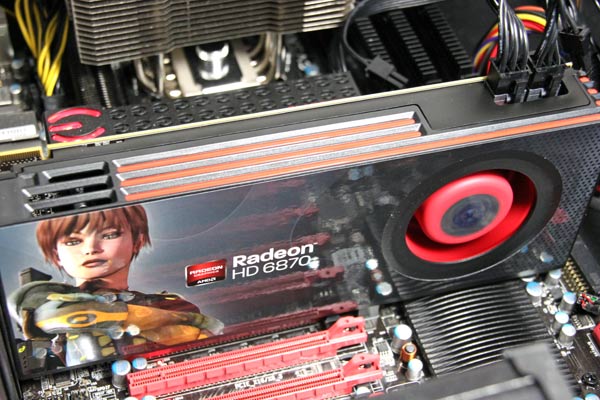
HD 6870 is AMD’s second in line DirectX 11 architecture codenamed Northern Islands. The graphics chip used on HD 6870 and HD 6850 is branded Barts and is made in 40nm. Barts is a direct result of AMD’s HD 5800 optimization efforts and it comes in two versions – Barts XT (HD6870) with 1120 shaders and Barts PRO (HD6850) with 960 shaders. The fine tuned architecture now provides better performance per watt and mm2 compared to the previous, Evergreen generation.
Sapphire HD 6870 will cost you about €204, here. Judging by the price and performance, Sapphire HD 6870 already sounds like a nice deal especially for those on the prowl for a decent gaming card. Below you see GPUZ snapshot confirming the card’s reference clock. You can find plenty of other info as well, such as compute power of 2.0 TFLOPs.
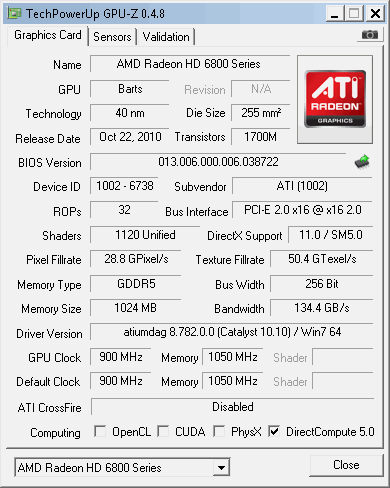
Sapphire’s HD 6870 is a reference design. The card is 9.5 inches long, pretty much like the HD 5850, and their respective performances are pretty close as well.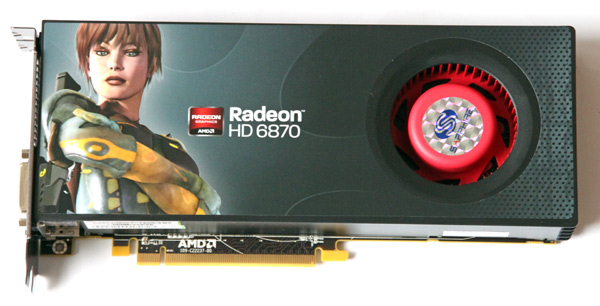
Sapphire HD 6870’s cooler is dual slot and quiet. Fan speed is automatically regulated, but if you want full control you can always use Catalyst Overdrive. For HD 6800 owners, Sapphire has a new version of TriXX tweak utility, which can be used for fan RPM regulation, overclocking and GPU voltage changes entirely in software.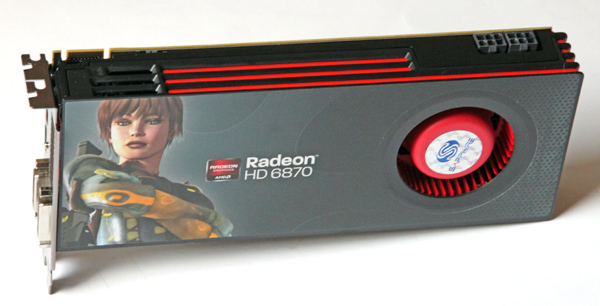
Compared to the HD 5000 series, the new HD 6000 series packs more outs on the cards’ I/O panel. There are two mini-DisplayPort 1.2 connectors, one HDMI 1.4a and two DVI connectors. One DVI connector is single link with maximum resolution of 1920x1200 whereas the other is dual-link with maximum resolution of 2560x1600.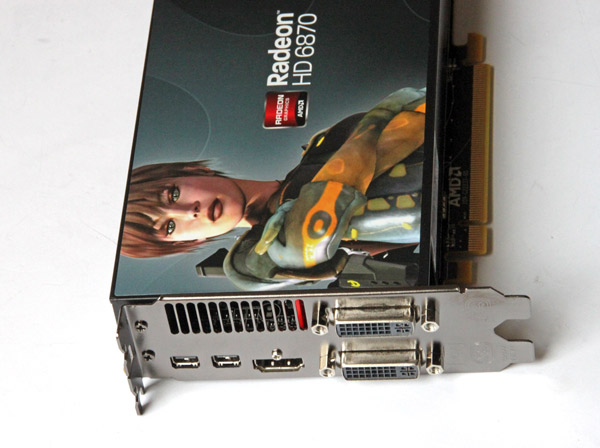
HD 6800 series pretty much made the HD 5000’s Eyefinity 6 cards obsolete, as now each HD 6800 can run up to six monitors. This is thanks to multi-stream technology and will only take two mini-DisplayPorts but you will need a DisplayPort hub.
As for audio, Dolby TrueHD, DTS-HD, AC-3, DTS i and up to 7.1 channel audio are supported via HDMI 1.4a at 192KHz/24bit resolution.
Unlike the HD 5850, the HD 6870 has only one CrossFire connector. This means that 2-way CrossFire is basically the only CrossFire configuration possible.
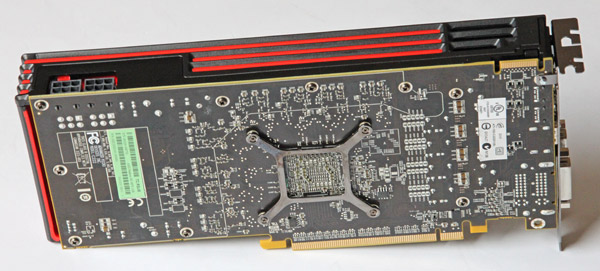
Radeon HD 6870 is powered via two power connectors. Its maximum consumption is 151W, whereas one connector provides “only” 150W.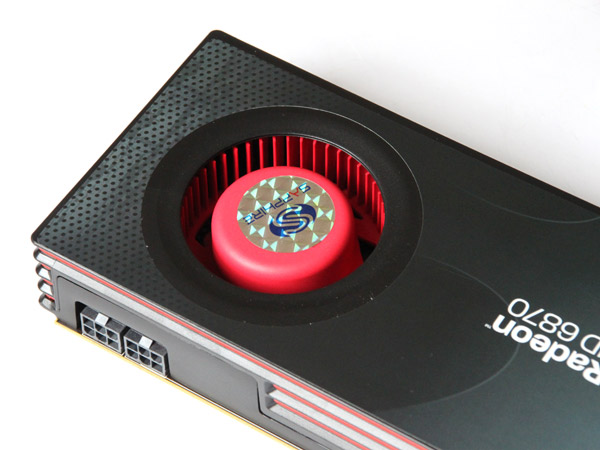
Sapphire HD 6870 packaging is eye catching, like always. Within the box (made of recycled paper), you’ll find the standard stuff as well as an HDMI 1.4a cable (1.8m) and a mini-DisplayPort-to-DisplayPort dongle.
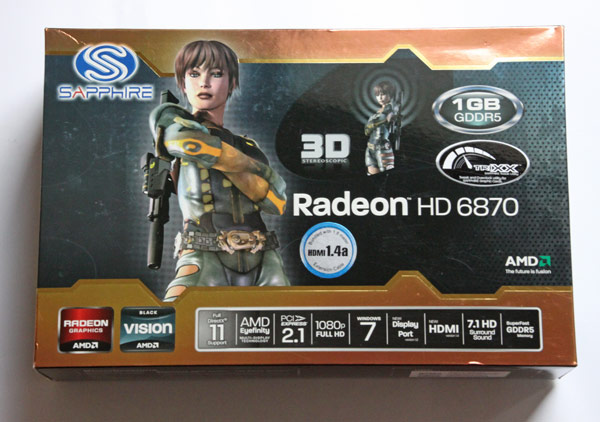
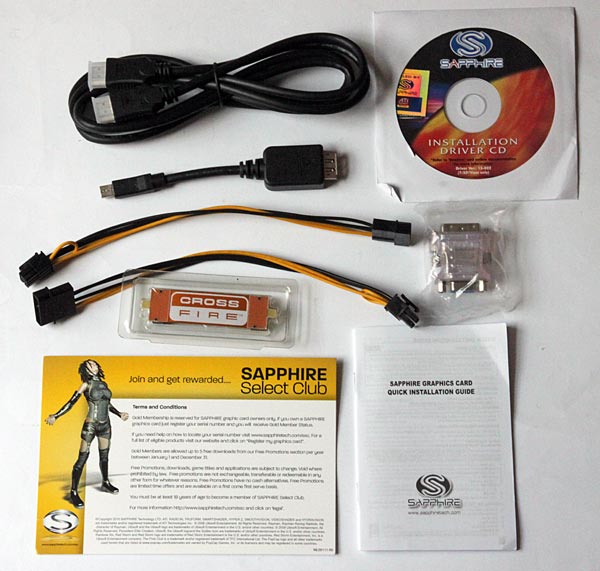
Testbed:
Motherboard: EVGA 4xSLI
CPU: Core i7 965 XE (Intel EIST and Vdrop enabled)
Memory: 6GB Corsair Dominator 12800 7-7-7-24
Harddisk: OCZ Vertex 2 100 GB
Power Supply: CoolerMaster Silent Pro Gold 800W
Case: CoolerMaster HAF X
Fan Controler: Kaze Master Pro 5.25"
Operating System: Win7 64-bit
260.89_desktop_win7_winvista_64bit_english
10.10 CCC
Our test results feature another HD 6870 card that’s also reference designed and clocked, so the results are almost identical to those scored by Sapphire’s card. 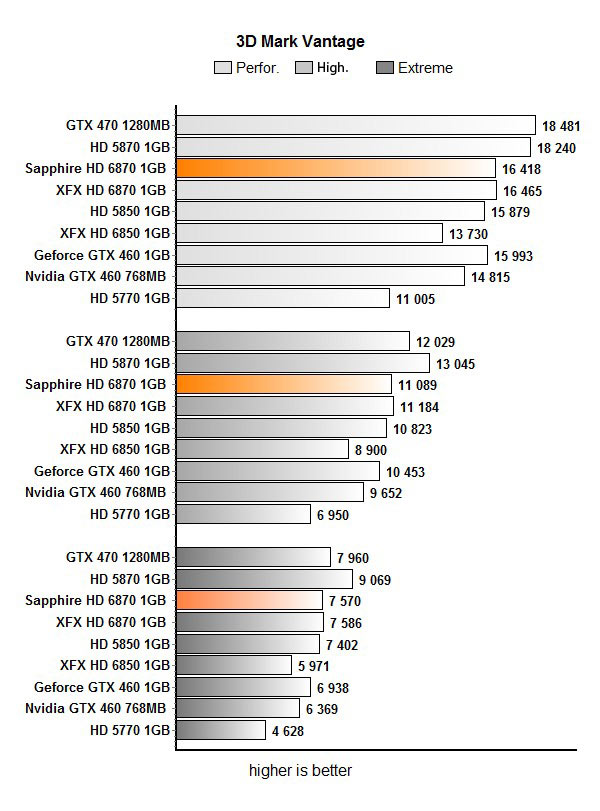
Sapphire HD 6870 allows for pleasant gaming at 1920x1080 and the results confirm that the card is faster than the HD 5850.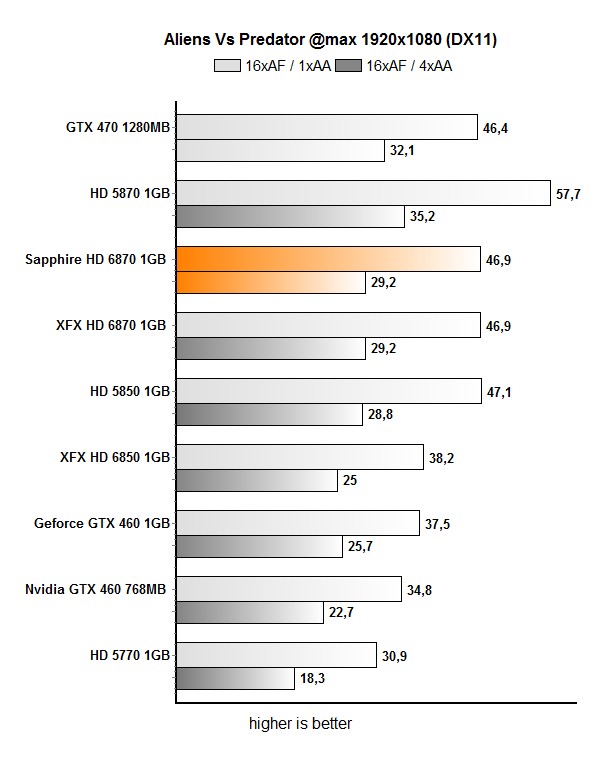
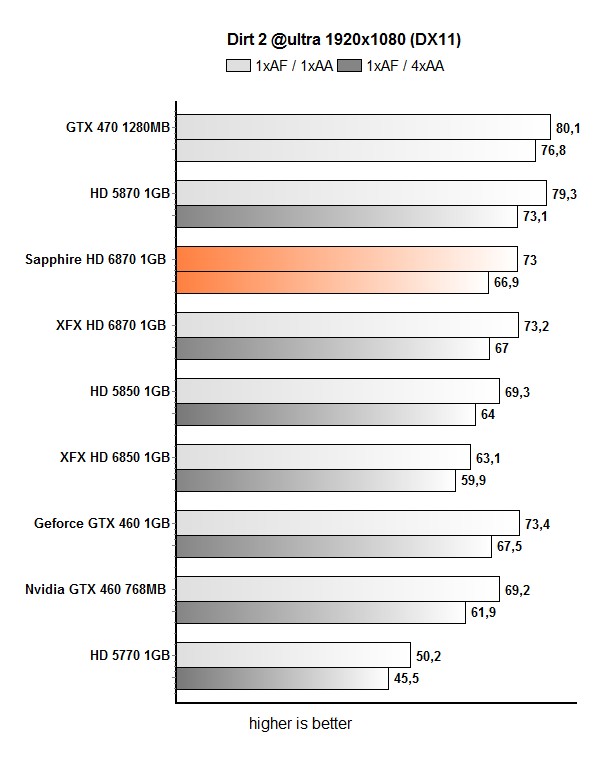
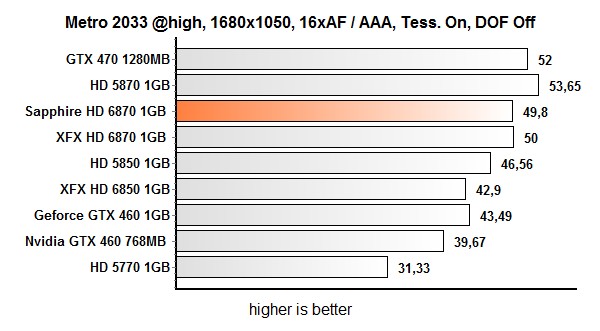
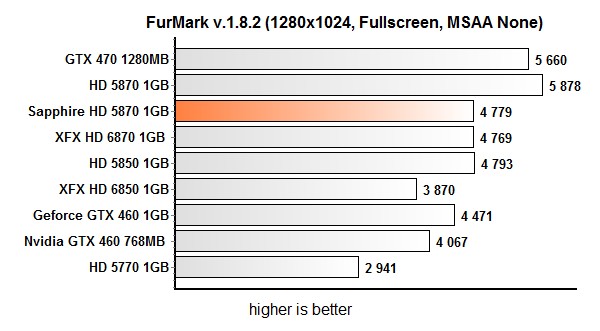
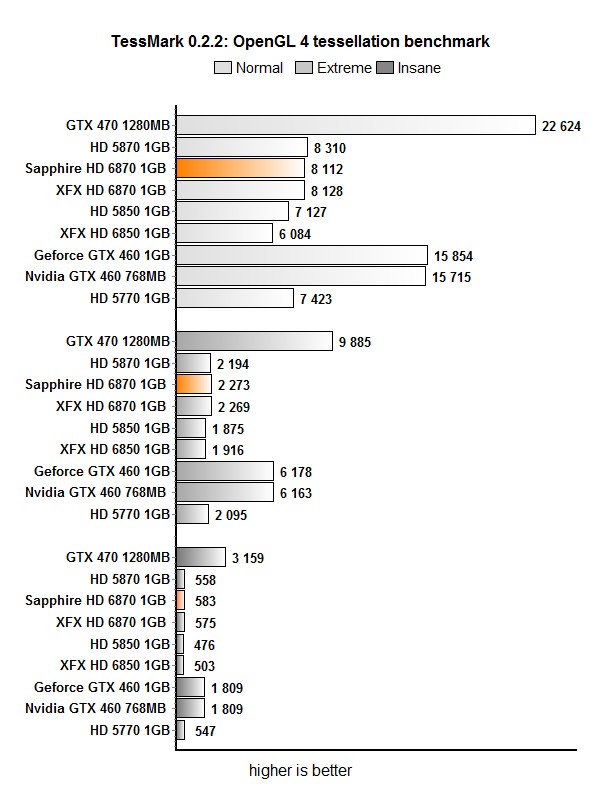
Overclocking
Sapphire’s HD 6870 is a reference designed and clocked card, meaning the GPU runs at 900MHz and the memory at 1050MHz (4200MHz effectively). For our overclocking, we used MSI’s Afterburner v2.0, which allows for altering GPU and memory clocks, regulating fan RPM but not altering voltages in software. Thanks to Sapphire, however, HD 6800 owners can download a free overclocking tool called TriXX, which allows for meddling with GPU voltages entirely in software.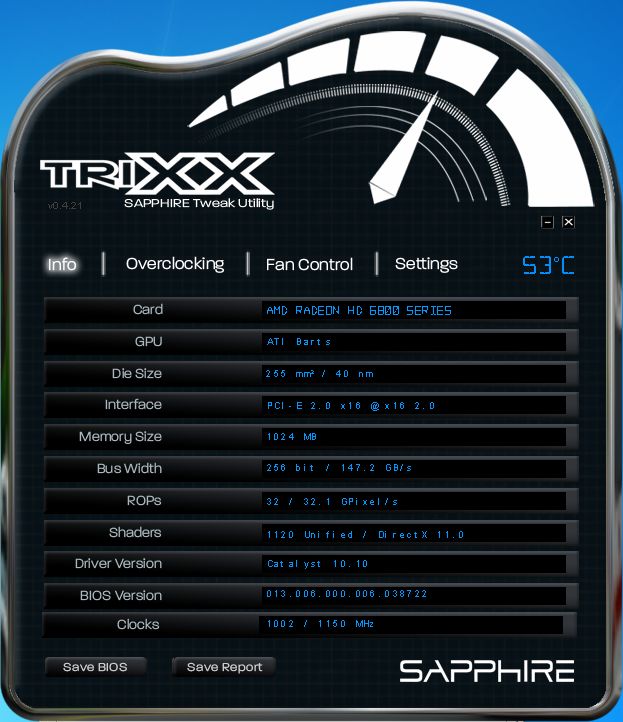
Without changing the voltage we managed to push the GPU from 900MHz to 950MHz, whereas upping the voltage to 1.299mV resulted in stable 1002MHz for the GPU. 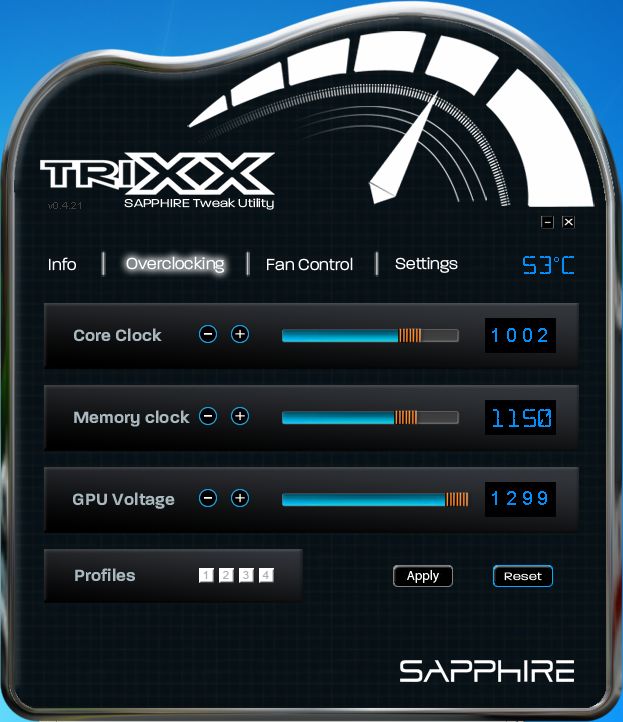
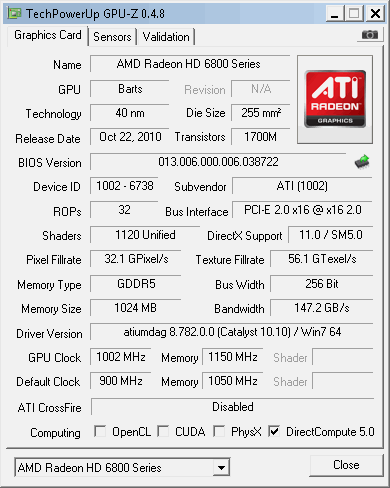
Overclocking
The game Aliens vs. Predator reports our freshly overclocked HD 6870 to be performing about 9% faster.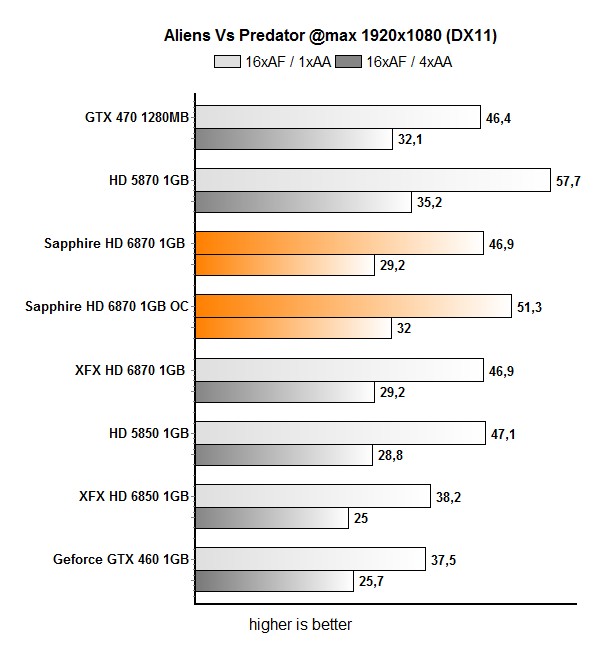
Thermals and Noise
The card wasn’t loud during gaming, not even after we pushed the GPU to 1GHz (auto fan RPM).
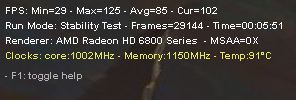
If you want lower GPU temperatures, you can always manually increase the fan RPM – at 50% RPM temperature was at 87°C.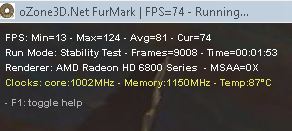
Reference clocked GPU was around 84°C with the fan RPM set at AUTO.
After overclocking our Sapphire HD 6870 to 1GHz, our entire rig consumed up to 60W more.
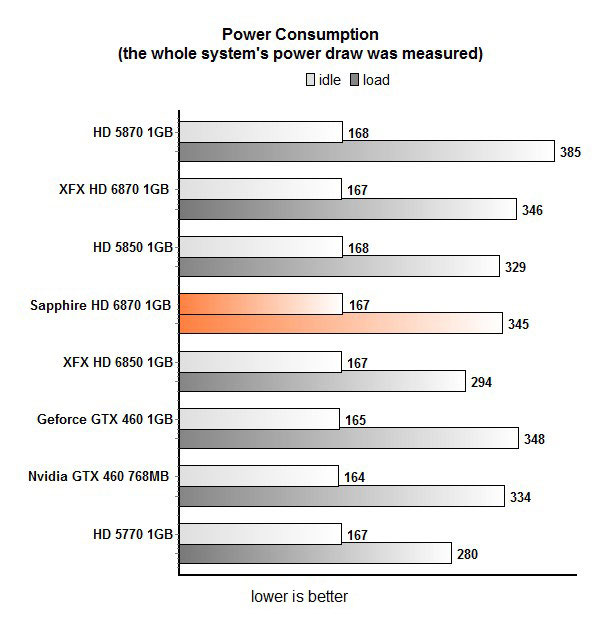
Conclusion
AMD recently announced the HD 6800 series, and our today’s test subject was Sapphire’s HD 6870. The card is priced at about €204, which is a pretty good bang for a buck. With its HD 6800 series, AMD introduced competition to HD 5800 series by offering good performance at a lower price.
Radeon HD 6870 uses the new Barts XT core. Barts is a part of Northern Islands family, AMD’s second DirectX 11 generation. In layman’s terms, Barts is an optimized version of Cypress, the chip behind HD 5850/5870 cards.
Of course, Sapphire is well known to adding its own flavor to the cards, and HD 6850 is no exception. In fact, the company offers HD 6850 Toxic and Vapor-X cards, aiming at Gamers’ sweet spot segment.
Sapphire HD 6870 offers plenty of overclocking potential, as long as you use TriXX tweak utility which allows for upping GPU voltages. We managed to push the GPU to 1GHz. The cooler, which wasn’t very loud during gaming, is almost inaudible in idle mode and wasn’t much louder even after our overclocking.
Sapphire included a 1.8m long HDMI 1.4a cable and a mini-DisplayPort-to-DisplayPort dongle, making this package even sweeter.
Low consumption, improved video engine (UVD 3), HDMI 1.4a for 3D Blu-ray, two DisplayPort 1.2 outs with Multi-Stream support (up to 6 monitors via two DisplayPorts) are just some of the good things on this card. So, in case you’re looking for an affordable DirectX 11 card for gaming and entertainment, Sapphire HD 6870 should definitely make your list.
